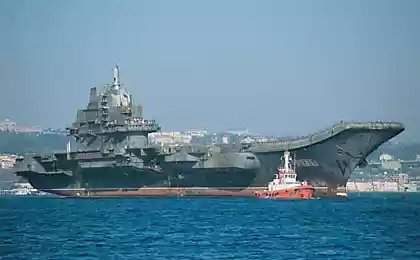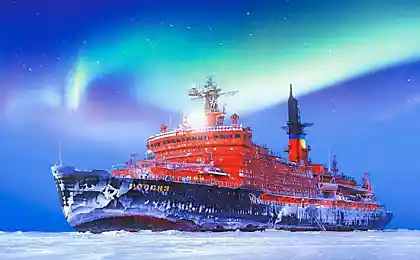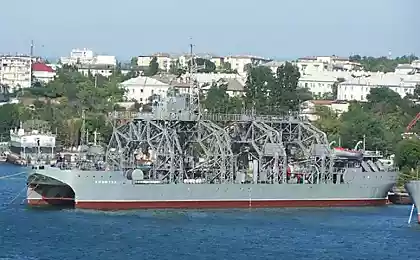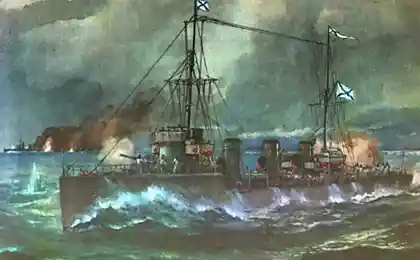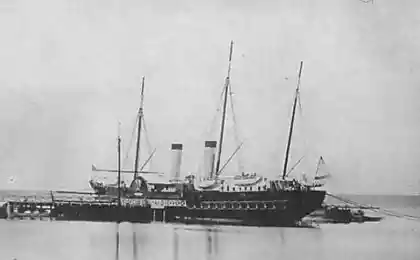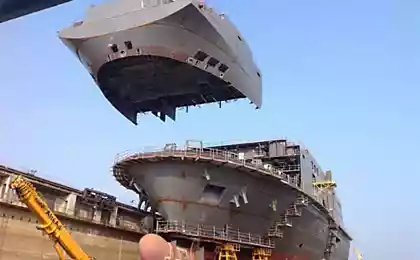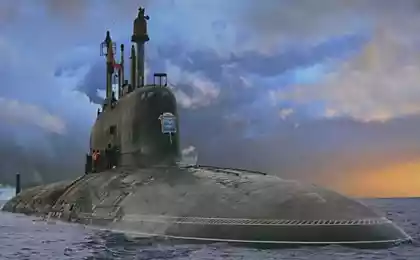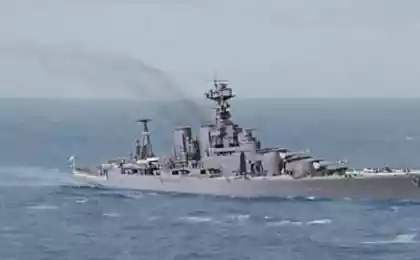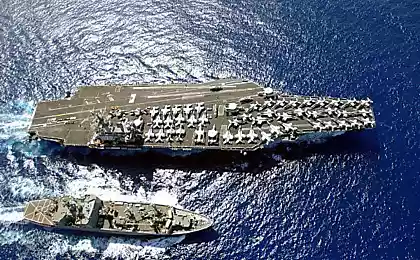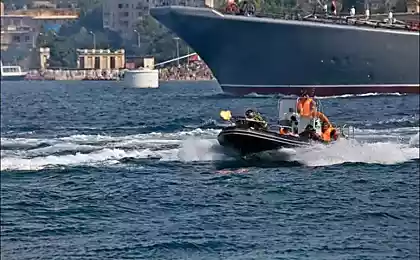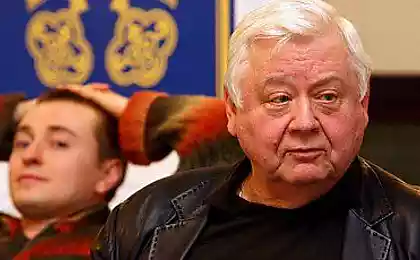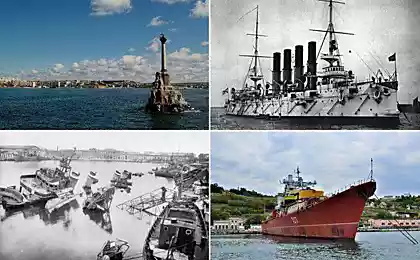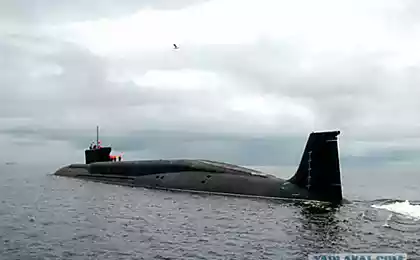2421
Russian nuclear icebreakers. History of the Russian Navy
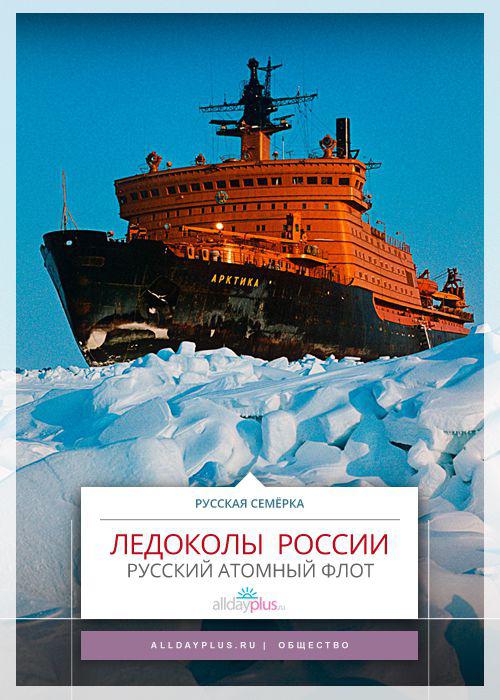
«Lenin»
At the time of his favorites icebreaker "Lenin" was the first ship in the world, equipped with a nuclear power plant and the first atomic civilian vessel. Launched on December 5, 1957. Nuclear power plant installed in the 1958-1959's. August 6, 1959 Physical start of a nuclear reactor. September 12th, 1959 Admiralty shipyard since the plant went on sea trials under the command PA Ponomareva. The most important differences between its high level of autonomy and power. Already during his first use of the vessel demonstrates superior performance, which helped to significantly increase during navigation. During the first six years of using nuclear icebreaker traveled more than 82,000 nautical miles, spent more than 400 ships. Later, "Lenin" first of all courts would north of Severnaya Zemlya.
Icebreaker twice case of emergency with nuclear reactors: the first in 1965, the second - in 1967. The second state of emergency has led to serious damage to one of the three reactors OK-150 and replace them with two reactor OK-900. In June 1971, the icebreaker "Lenin" first surface vessels passed north of Severnaya Zemlya. Flight began and ended in Murmansk in Pevek. Thus was prepared the expedition icebreaker "Arktika" to the North Pole in 1977. From this expedition was brought Bear, after the expedition sent to the Leningrad Zoo.

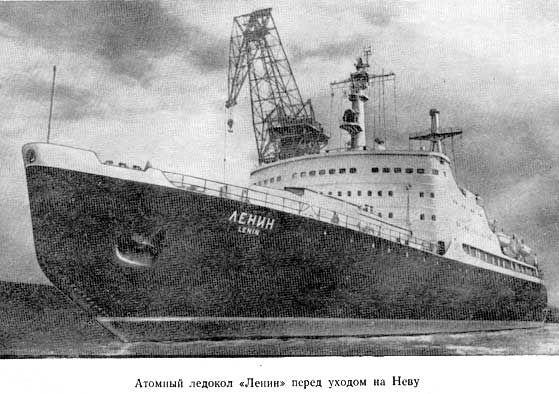

Icebreaker "Lenin" has worked for 30 years and in 1989 it was decommissioned and put on eternal parking in Murmansk. Who icebreaker is a museum, work is underway to expand the exposure.
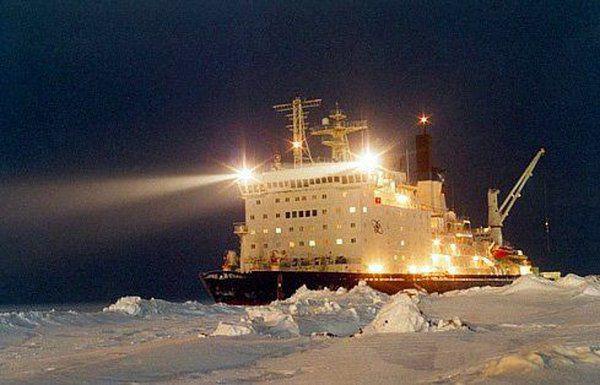
«Arctic»
Class icebreaker "Arktika" - the basis of the Russian nuclear icebreaker fleet: 6 out of 10 nuclear-powered icebreakers are in class Arctic.
Icebreakers this class have a double hull, can break the ice, moving both forward and backward. These ships are designed to operate in the cold Arctic waters, which complicates the operation of a nuclear installation in the warm seas. This is partly why the intersection of the tropics to work off the coast of Antarctica in the objectives is not included. Typically, to ensure sufficient energy of the ship only one of the two reactors, the ship during the voyage but both involved (less than 50% of power).
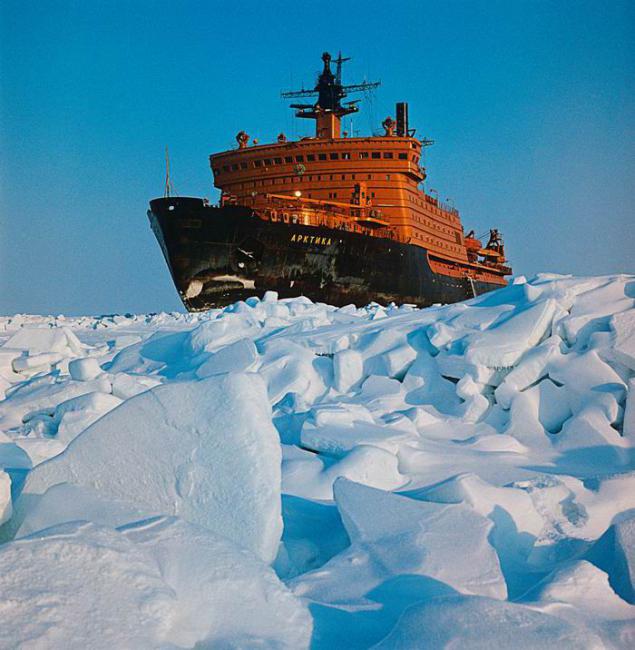
Nuclear-powered icebreaker "Arktika" (launched in 1975) was considered the largest in existence at that time, its width is 30 meters, length - 148 meters and the depth - more than 17 meters. The unit was equipped with a medical unit, where present operating and dental unit. The vessel had all the conditions enabling based flight and helicopter. "Arctic" was able to break through the ice with a thickness of five meters, and move at a speed of 18 knots. A clear distinction was considered unusual and painting of the vessel (bright red), which represents a new era moreplavatelskuyu. A nice icebreaker was the fact that he was the first ship that managed to reach the North Pole.
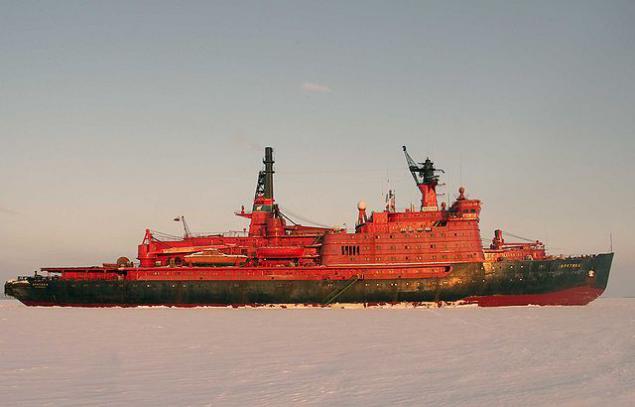
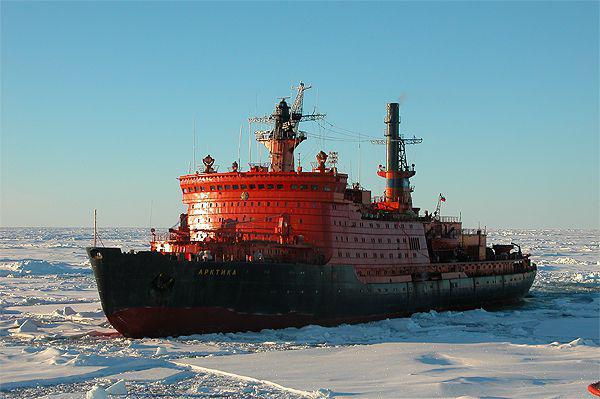
«Siberia»
Nuclear icebreaker "Sibir" - Soviet nuclear icebreaker Arktika class. Built on the Baltic Plant. Sergo Ordzhonikidze in Leningrad. Put into operation December 28, 1977.
Is the world's third largest icebreaker with a nuclear power plant, the second surface vessel in the history of Arctic navigation, active swimming reached the top of the world - May 25, 1987 at 15 hours 59 minutes Moscow time icebreaker "Sibir" was released in the North Pole.
The vessel has a satellite communications system that provides the navigation, telephone, fax machine, a large dining room, library, lounge lounge, fitness room, pool, sauna.
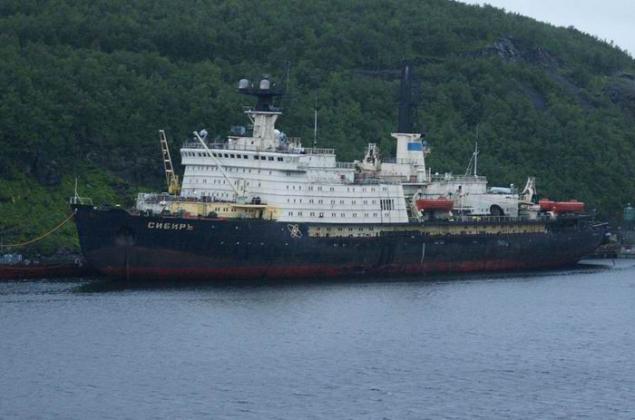

Since 1993, mothballed due to a malfunction of steam generators.
Currently, the icebreaker is cold sludge and fully prepared for cutting: Go dock repair, vessel cleaned with waste and nuclear fuel, the bottom is sealed. According to the plans, recycling will take place after 2015.
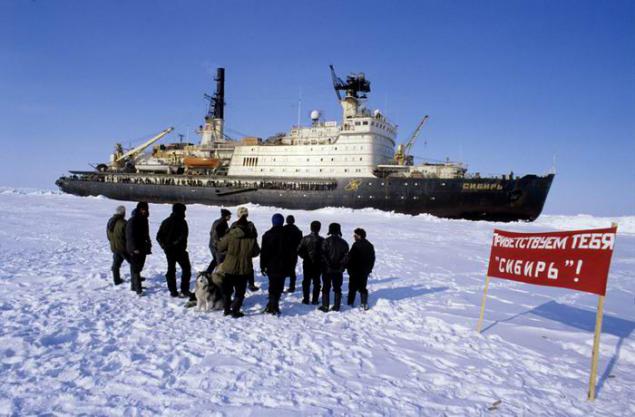
«Russia»
Nuclear icebreaker "Russia" - class icebreaker "Arktika", founded February 20, 1981 at the Baltic Plant. Sergo Ordzhonikidze in Leningrad, launched on November 2, 1983, was commissioned 21 December 1985, is the fourth in the world icebreaker with a nuclear power plant.
Etto unsinkable icebreaker, was the first of a series of Arctic nuclear power plants, whose power reaches 55, 1 MW (75 thousand. Horsepower). At the disposal of the crew have internet access, lounge "Nature" with the aquarium and live vegetation, chess room, cinema room, and everything else that was present on the icebreaker "Sibir". The main purpose of the installation, cooling of nuclear reactors and in the conditions of use of the Arctic Ocean. As the ship was forced to reside in cold water, it could not overcome the tropics to find himself in the Southern Hemisphere. For the first time on this ship was made cruise flight to the North Pole, specially organized for foreign tourists. And in the XX century on the nuclear icebreaker made study of the continental shelf in the North Pole.


"The Soviet Union»
"Soviet Union" - the Russian nuclear icebreaker class "Arctic", built at the Baltic Shipyard in St. Petersburg. Launched on October 31, 1986, put into operation in 1989. Included in the Murmansk Shipping Company and used.
Icebreaker is designed so that in a short time that it can be retrofitted in a combat ship. Some of this equipment is in caretaker status on the board, and some - at coastal warehouses. In particular, on the tank before felling fire control radar mounted removable artillery installation MR-123 ... Originally, the ship was used for Arctic tourism. Making transpolar cruise, with his side managed to establish meteorological ice stations operating in automatic mode, as well as the American Meteorological buoy. Later icebreaker standing near Murmansk, used for power supply facilities located near the coast. Also the ship has found application in the study of the Arctic impacts of global warming.

Currently, the icebreaker is planned to restore, but only after a specific customer will be determined or until the increased transit through the Northern Sea Route, and there will be new areas of work. As stated in the August 2014 General Director Vyacheslav Rosatomflota Ruksha, "we extend the service life of the icebreaker" Soviet Union ", restore it by 2017, which will enable us to withstand the load 2017-2018 years when the old icebreakers will be scrapped and new ones have not appear. Given the commissioning of major projects in the Russian Arctic, the growing interest of international shipowners to transit along the Northern Sea Route, the task of the sailors, as well as a positive trend of increasing the area of ice on the affected waters, the need for powerful icebreakers with nuclear power plant will only grow. "
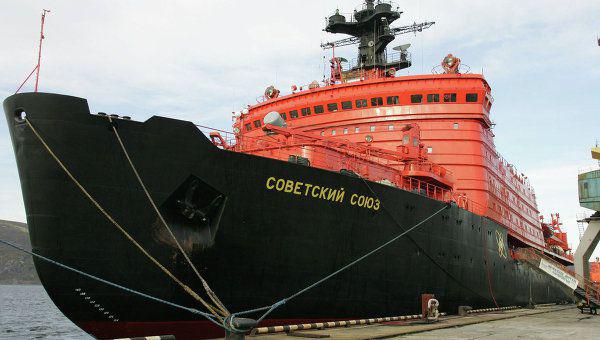
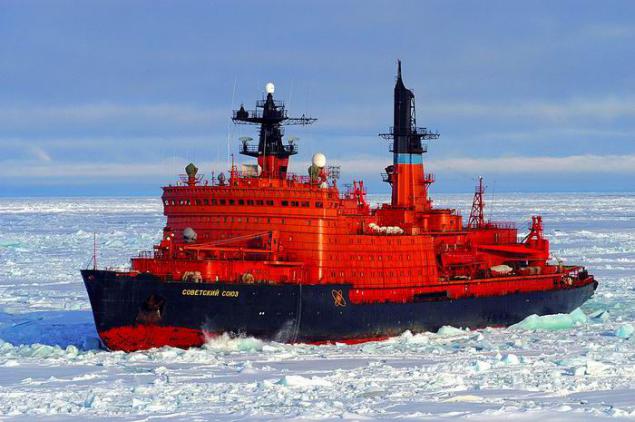
«Yamal»
Nuclear icebreaker "Yamal" Launched in 1993, became the twelfth ship, which reached the North Pole.
The ship bears the one Mi-8T and several boats Zodiac class. On it is a satellite system, providing navigation, telephone, fax and Internet, designed for office use. The vessel has a large dining room, a library, a hall for passengers, volleyball court, fitness room, heated pool, sauna and a hospital.
The stylized image of shark mouth on the nose icebreaker appeared in 1994 as a design element for children's cruise, then left at the request of tour companies, and eventually became a tradition.
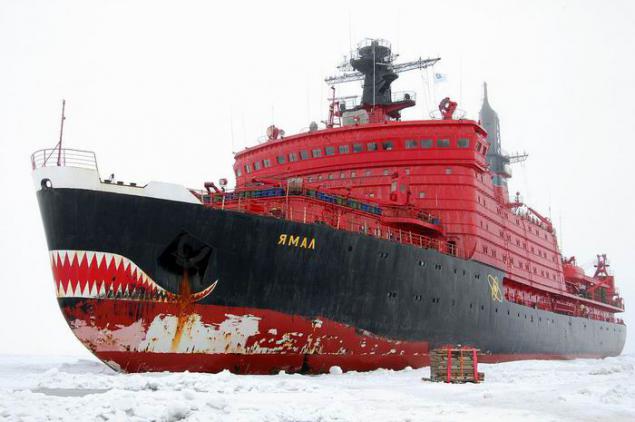

"50 Years of Victory»
"50 Years of Victory" - the eighth nuclear icebreaker, built at the Baltic Shipyard and today - the largest in the world. Icebreaker is an upgrade project of the second series of nuclear icebreakers of the "Arctic". "50 Years of Victory" - the project is largely experimental. The vessel used spoon-shape bow, first used in the development of the 1979 Canadian pilot icebreaker "Kenmar Kigoriyak" and convincingly proven effective in experimental operation. Icebreaker installed digital automatic control system of the new generation. Upgraded suite of biological protection of nuclear power plant, the last re-examination in accordance with the requirements Gostekhnadzor. Created as an environmental compartment, equipped with the latest equipment for the collection and disposal of all waste products of the vessel.

New icebreaker USSR was founded October 4, 1989 at the Baltic Plant of Leningrad under the name "Ural". And although in the USSR nuclear submarines fully rented for two or three years, "Ural" only for launching took four. December 29, 1993 icebreaker was launched, but due to lack of financing its construction was halted and the huge vessel and left to stand at the pier is only half finished. In 1995 it was renamed the icebreaker was renamed the "50 Years of Victory". icebreaker in fitting-prichalaZa many years of useless idle at the dock "Baltic Shipyard" ship several times miraculously escaped disposal.
Construction of the nuclear-powered icebreaker was continued in 2003, after the "Baltic Shipyard" entered the structure shipbuilding assets of United Industrial Corporation, and for the completion of the nuclear icebreaker been allocated public funds.
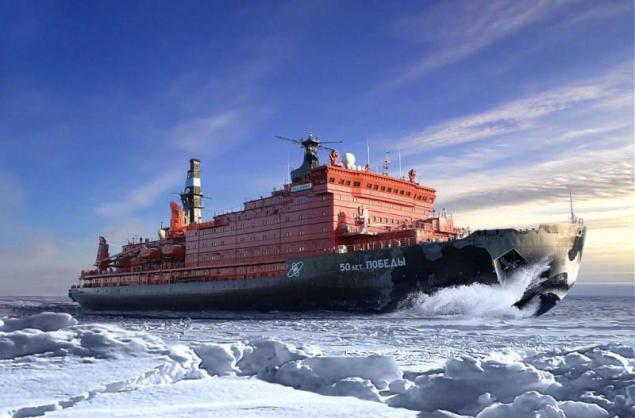
February 1, 2007, the company completed mooring trials atomic icebreaker "50 Years of Victory" during which launched a nuclear reactor vessel. February 17 government successfully completed sea trials. Icebreaker showed high maneuverability, reliability and maximum speed of 21, 4 node.
March 23, 2007 on the nuclear icebreaker "50 Years of Victory" was signed acceptance report vessel "Murmansk Shipping Company" and hoisted the national flag of the Russian Federation. April 2, 2007 icebreaker left the "Baltic Shipyard" and April 11, 2007 came to a permanent home port of Murmansk.
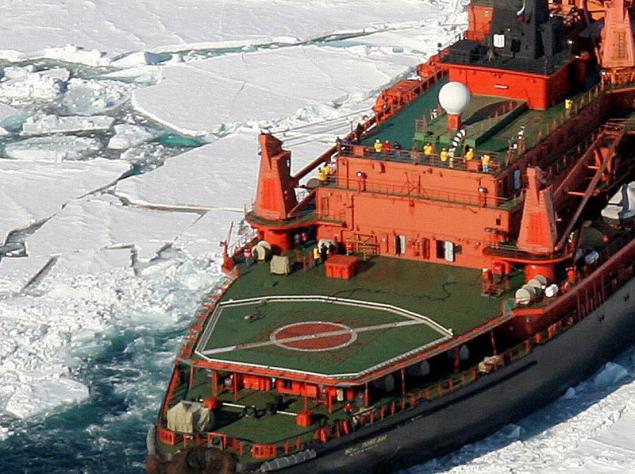
Source: Internet


